
Greater Queens Podiatry, PLLC
 (718) 229-0222
(718) 229-0222
 (718) 229-0222
(718) 229-0222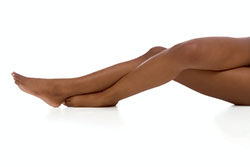 There are many ways for you to help your feet stay healthy every day. One of them is to make sure your feet are always dry. You should also wear shower shoes while using a public shower in order to prevent fungus. Another way to maintain healthy feet is to avoid wearing narrow or high heeled shoes; these types of shoes force your feet into unnatural positions which can result in bunions or blisters.
There are many ways for you to help your feet stay healthy every day. One of them is to make sure your feet are always dry. You should also wear shower shoes while using a public shower in order to prevent fungus. Another way to maintain healthy feet is to avoid wearing narrow or high heeled shoes; these types of shoes force your feet into unnatural positions which can result in bunions or blisters.
Every day foot care is very important, especially for those that are lacking the proper foot care resources. For more information about everyday foot care, contact Dr. Nicholas Megdanis from Greater Queens Podiatry PLLC. Our doctor will assist you with all of your podiatric concerns.
Every Day Foot Care
Often, people take care of their bodies, face and hair more so than they do for their feet. But the feet are a very important aspect of our bodies, and one that we should pay more attention to. After all, without our feet, we would not be able to perform most daily tasks. It is best to check your feet regularly to make sure there are no new bruises or cuts that you may not have noticed before, for example.
For dry feet, moisturizer can easily be a remedy and can be applied as often as necessary to the affected areas. Wearing shoes that fit well can also help you maintain good foot health, as well as making it easier to walk and do daily activities without the stress or pain of ill-fitting shoes, high heels, or even flip flops.
Also, wearing clean socks with closed shoes is important to ensure that sweat and bacteria do not accumulate within the shoe. Clean socks help to prevent athlete’s foot, fungi problems, bad odors, and can absorb sweat.
If you have any questions please feel free to contact our office located in Bayside, New York. We offer the newest diagnostic and treatment technologies for all your foot and ankle needs.
Read more about Everyday Foot Care
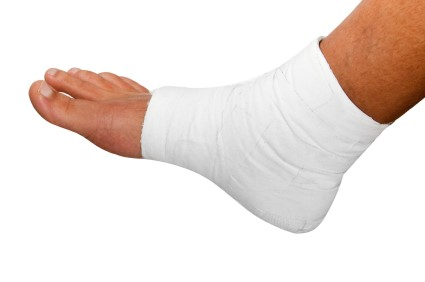 Buffalo Bills wide receiver Sammy Watkins complained of pain in his left foot earlier in the offseason. After having his foot checked out, it was revealed that the pain he felt was due to a stress fracture. Watkins is recovering from foot surgery and says he is excited to get rid of his walking boot and resume normal activity.
Buffalo Bills wide receiver Sammy Watkins complained of pain in his left foot earlier in the offseason. After having his foot checked out, it was revealed that the pain he felt was due to a stress fracture. Watkins is recovering from foot surgery and says he is excited to get rid of his walking boot and resume normal activity.
Activities where too much pressure is put on the feet can cause stress fractures. To learn more, contact Dr. Nicholas Megdanis from Greater Queens Podiatry PLLC. Our doctor can provide the care you need to keep your pain free and on your feet.
Dealing with Stress Fractures of the Foot and Ankle
The Stress Fractures occur on the foot and ankle when muscles in these areas weaken from too much or too little use. Then the feet and ankles lose support when walking or running from the impact of the ground. Since there is no protection the bones receive the full impact of each step. The stress on the feet causes cracks to form in the bones, thus called stress fractures.
What are Stress Fractures?
tress fractures occur frequently in individuals whose daily activities cause great impact on the feet and ankles. Stress factors are most common among:
-runners
-people affected with Osteoporosis
-play tennis or basketball
-gymnastics
-high impact workouts
Symptoms
Pain from the fractures occur in the area of the fractures, and can be constant or intermittent. It will often cause sharp or dull pain with swelling and tenderness. Engaging in any kind of activity which involves in high impact will aggravate pain.
If you have any questions please feel free to contact one of our offices located in Bayside, New York. We offer the newest diagnostic and treatment technologies for all your foot and ankle needs.
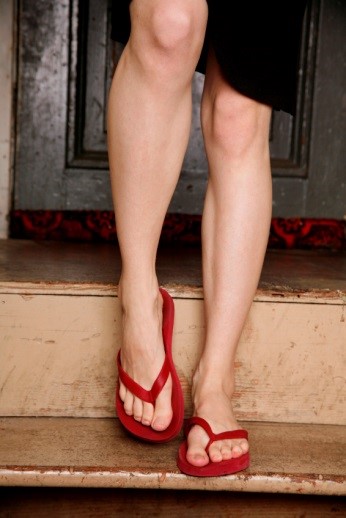 Why are flip-flops not considered suitable footwear? The answer lies in the fact that flip-flops are lacking arch support because they are flat, which can lead to extra stress on your feet. Wearing flip-flops for long periods or habitually also makes our feet more prone to ankle sprains. “Improper foot support can cause the knees to turn in, pelvis misalignments, and even cause poor posture.” It is recommended that you instead look for shoes that have good arch support, thick soles, and good traction.
Why are flip-flops not considered suitable footwear? The answer lies in the fact that flip-flops are lacking arch support because they are flat, which can lead to extra stress on your feet. Wearing flip-flops for long periods or habitually also makes our feet more prone to ankle sprains. “Improper foot support can cause the knees to turn in, pelvis misalignments, and even cause poor posture.” It is recommended that you instead look for shoes that have good arch support, thick soles, and good traction.
Flip-flops are not always the best choice of footwear. If you have any questions concerning the feet, contact Dr. Nicholas Megdanis from Greater Queens Podiatry PLLC. Our doctor will assist you with all of your foot and ankle needs.
Flip-Flops and Feet
When the weather starts warming up, people enjoy wearing flip-flops. Flip-flops are comfortable, stylish, and easy to slip on and off, perfect for any summer beach goer. However, these shoes can cause harm to the feet.
How Can Flip-Flops Affect Me Long-Term?
Ankle problems
Hip problems
Lower back problems
Pain in the balls of the feet
Problems with foot arches
Changes in the way you walk
Are there injuries associated with flip-flops?
Yes. Since flip-flops are relatively weak and do not provide the same amount of support as sneakers, people who wear flip-flops are more susceptible to injuries. On top of that, the open nature of the shoe makes your feet more prone to other problems, such as cuts and even infections. Common injuries and ailments include:
Sprained ankles
Blisters
Infections
Cuts and Scrapes
I like wearing flip-flops, are there safe alternatives?
When buying flip-flops, try to find ones that have sturdy soles and are made of high quality materials that will support for your feet. These flip-flops will cost more, but will also last longer as a result.
If you have any questions, please feel free to contact our office located in Bayside, New York. We offer the newest diagnostic and treatment technologies for all your foot and ankle needs.
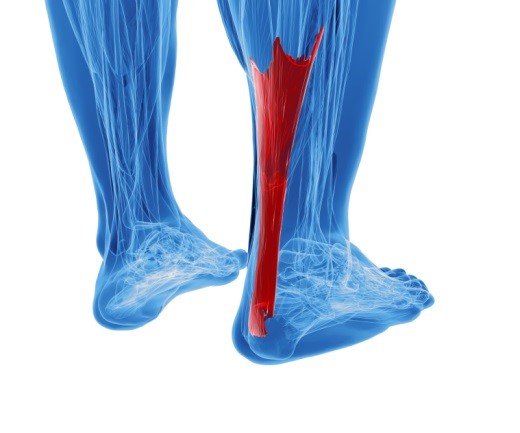 High-contact sports and sports that are strenuous such as lacrosse can lead to the onset of foot conditions such as heel pain. Sever’s disease is one particular condition associated with heel pain, described as “an inflammation of the growth area (heel plate) of the heel bone which has not completely matured, or closed together, and has developed in two parts.” Sever’s disease occurs most commonly in adolescent athletes from the ages of 10 to 15. The pain begins in the back of the heel, and can be caused by factors such as abnormal pronation of the feet, ill-fitting shoes, and improper use of the feet.
High-contact sports and sports that are strenuous such as lacrosse can lead to the onset of foot conditions such as heel pain. Sever’s disease is one particular condition associated with heel pain, described as “an inflammation of the growth area (heel plate) of the heel bone which has not completely matured, or closed together, and has developed in two parts.” Sever’s disease occurs most commonly in adolescent athletes from the ages of 10 to 15. The pain begins in the back of the heel, and can be caused by factors such as abnormal pronation of the feet, ill-fitting shoes, and improper use of the feet.
Anyone can wind up suffering from heel pain. For more information, contact Dr. Nicholas Megdanis from Greater Queens Podiatry PLLC. Our doctor will treat your foot and ankle needs.
Causes of Heel Pain
● Heel pain is often associated with plantar fasciitis. The plantar fascia is a band of tissues that extends along the bottom of the foot. A rip or tear in this ligament can cause inflammation of the tissue.
● Achilles tendonitis is another cause of heel pain. Inflammation of the Achilles tendon will cause pain from fractures and muscle tearing. Lack of flexibility is also another symptom.
● Heel spurs are another cause of pain. When the tissues of the plantar fascia undergo a great deal of stress, it can lead to ligament separation from the heel bone, causing heel spurs.
Why Might Heel Pain Occur?
- Wearing ill-fitting shoes
- Wearing non-supportive shoes
- Weight change
- Excessive running
Treatments
Heel pain should be treated as soon as possible for immediate results. Keeping your feet in a stress free environment will help. If you suffer from Achilles tendonitis or plantar fasciitis, applying ice will reduce the swelling. Stretching before an exercise like running will help the muscles. Using all these tips will help make heel pain a thing of the past.
With the advancements in technology and greater knowledge of how muscles and joints work, physical therapists can turn things around dramatically.
If you have any questions, please feel free to contact our office located in Bayside, New York. We offer the newest diagnostic and treatment technologies for all your foot and ankle needs.
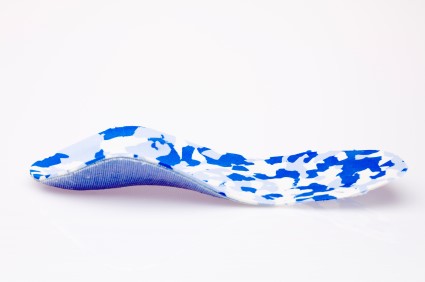 As our feet may develop foot conditions such as the flattening of our arches, consider custom orthotics as a potential treatment option. There exist three different types of orthotics: rigid, soft, and semi-rigid. “Each orthotic is concerned with improving the functionality of a patient’s feet, minimizing the stress forces that could potentially cause pain or deformity.” Orthotics can help address foot problems such as arch pain, plantar fasciitis, and any other pain associated with the feet.
As our feet may develop foot conditions such as the flattening of our arches, consider custom orthotics as a potential treatment option. There exist three different types of orthotics: rigid, soft, and semi-rigid. “Each orthotic is concerned with improving the functionality of a patient’s feet, minimizing the stress forces that could potentially cause pain or deformity.” Orthotics can help address foot problems such as arch pain, plantar fasciitis, and any other pain associated with the feet.
If you are having discomfort in your feet and would like to try orthotics, contact Dr. Nicholas Megdanis from Greater Queens Podiatry PLLC. Our doctor will treat your foot and ankle needs.
What are Orthotics?
Orthotics are inserts you can place into your shoes to help with a variety of foot problems such as flat feet or foot pain. Orthotics provide relief and comfort for minor foot and heel pain, but can’t correct serious biomechanical problems in your feet.
Over-the-Counter Inserts
Orthotics come in a wide variety of over-the-counter inserts that are used to treat foot pain, heel pain, and minor problems. For example, arch supports can be inserted into your shoes to help correct over arched or flat feet, while gel insoles are often used because they provide comfort and relief from foot and heel pain by alleviating pressure.
Prescription Orthotics
If over-the-counter inserts don’t work for you, or if you have a more severe foot issue, it is possible to have your podiatrist prescribe custom orthotics. These high quality inserts are designed to treat problems such as abnormal motion, plantar fasciitis, and more severe heel pain. They can even be used to help patients suffering from diabetes by treating foot ulcers and painful calluses, and are usually molded to your feet individually, which allows them to provide full support and comfort.
If you are experiencing minor to severe foot or heel pain, it’s recommended to speak with your podiatrist on the possibilities of using orthotics. A podiatrist can determine which type of orthotic is right for you and allow you to take the first steps towards being pain free.
If you have any questions, please feel free to contact our office located in Bayside, New York. We offer the newest diagnostic and treatment technologies for all your foot and ankle needs.
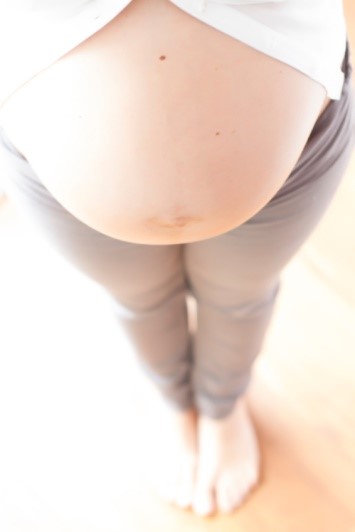 For women who are experiencing or will experience pregnancy, there are many different developments to the body as it changes. Our bodies will begin to create high levels of progesterone, “a hormone that manages fluid retention.” Fluid can begin to accumulate in our legs and feet, especially nearing birth. This leads to our legs and feet swelling, requiring rest and elevation. Make sure to take proper care of your pregnant feet as they are the foundations of our body, especially during such an important time.
For women who are experiencing or will experience pregnancy, there are many different developments to the body as it changes. Our bodies will begin to create high levels of progesterone, “a hormone that manages fluid retention.” Fluid can begin to accumulate in our legs and feet, especially nearing birth. This leads to our legs and feet swelling, requiring rest and elevation. Make sure to take proper care of your pregnant feet as they are the foundations of our body, especially during such an important time.
Pregnant women are susceptible to aching and swollen feet and should be treated with care. If you are seeking treatment, contact Dr. Nicholas Megdanis from Greater Queens Podiatry PLLC. Our doctor will treat your foot and ankle needs.
What foot problems can arise during pregnancy?
One problem that can occur is over-pronation, which occurs when the arch of the foot flattens and tends to roll inward. This can cause pain and discomfort in your heels while you’re walking or even just standing up, trying to support your baby.
Another problem is edema, or swelling in the extremities. This often affects the feet during pregnancy, but tends to occur in the later stages.
How can I keep my feet healthy during pregnancy?
· Wearing orthotics can provide extra support for the feet and help distribute weight evenly
· Minimize the amount of time spent walking barefoot
· Wear shoes with good arch support
· Wear shoes that allow for good circulation to the feet
· Elevate feet if you experience swelling
· Massage your feet
· Get regular, light exercise, such as walking, to promote blood circulation to the feet
If you have any questions, please feel free to contact our office located in Bayside, New York. We offer the newest diagnostic and treatment technologies for all your foot and ankle needs.
 If you’re waking in the mornings with pain in your feet, it may be because you have plantar fasciitis. Plantar fasciitis is described as heel pain that occurs as a result of inflammation and injury of the plantar fascia, which stretches along the bottom of our feet’s soles. Our plantar fascias are “prone to overuse injuries,” and symptoms of the condition include “morning stiffness, stiffness after working out, and pain while walking barefoot.” Treating your plantar fasciitis involves investing in custom orthotics, changing your footwear, anti-inflammatory medication, splints and physical therapy.
If you’re waking in the mornings with pain in your feet, it may be because you have plantar fasciitis. Plantar fasciitis is described as heel pain that occurs as a result of inflammation and injury of the plantar fascia, which stretches along the bottom of our feet’s soles. Our plantar fascias are “prone to overuse injuries,” and symptoms of the condition include “morning stiffness, stiffness after working out, and pain while walking barefoot.” Treating your plantar fasciitis involves investing in custom orthotics, changing your footwear, anti-inflammatory medication, splints and physical therapy.
Plantar fasciitis can be very painful and inconvenient. If you are experiencing heel pain or symptoms of plantar fasciitis, consult with Dr. Nicholas Megdanis from Greater Queens Podiatry PLLC. Our doctor will assist you with all of your podiatric concerns.
What is Plantar Fasciitis?
Plantar fasciitis is the inflammation of the thick band of tissue that runs along the bottom of your foot, known as the plantar fascia, and causes mild to severe heel pain.
What Causes Plantar Fasciitis?
· Excessive running
· Non-supportive shoes
· Overpronation
· Repeated stretching and tearing of the plantar fascia
How Can It Be Treated?
· Conservative measures – anti-inflammatories, ice packs, stretching exercises, physical therapy, orthotic devices
· Shockwave therapy – sound waves are sent to the affected area to facilitate healing and are usually used for chronic cases of plantar fasciitis
· Surgery – usually only used as a last resort when all else fails. The plantar fascia can be surgically detached from the heel
While very treatable, plantar fasciitis is definitely not something that should be ignored. Especially in severe cases, speaking to your doctor right away is highly recommended to avoid complications and severe heel pain. Your podiatrist can work with you to provide the appropriate treatment options tailored to your condition.
If you have any questions, please feel free to contact our office located in Bayside, New York. We offer the newest diagnostic and treatment technologies for all your foot and ankle needs.
 Visiting your podiatrist is especially important if you’ve experienced foot pain that may be chronic. “According to a 2014 survey from the American Podiatric Medical Association, 77 percent of U.S. adults over age 18 have experienced foot pain.” Heel pain, in particular, can be caused by many different reasons, including plantar fasciitis, athletic injury, or achilles tendinopathy. Plantar fasciitis occurs when the band of tissue that runs along the bottom of your foot becomes inflamed, whereas achilles tendinopathy occurs when the Achilles tendon becomes overworked and stressed.
Visiting your podiatrist is especially important if you’ve experienced foot pain that may be chronic. “According to a 2014 survey from the American Podiatric Medical Association, 77 percent of U.S. adults over age 18 have experienced foot pain.” Heel pain, in particular, can be caused by many different reasons, including plantar fasciitis, athletic injury, or achilles tendinopathy. Plantar fasciitis occurs when the band of tissue that runs along the bottom of your foot becomes inflamed, whereas achilles tendinopathy occurs when the Achilles tendon becomes overworked and stressed.
Anyone can wind up suffering from heel pain. For more information, contact Dr. Nicholas Megdanis from Greater Queens Podiatry PLLC. Our doctor will treat your foot and ankle needs.
Causes of Heel Pain
● Heel pain is often associated with plantar fasciitis. The plantar fascia is a band of tissues that extends along the bottom of the foot. A rip or tear in this ligament can cause inflammation of the tissue.
● Achilles tendonitis is another cause of heel pain. Inflammation of the Achilles tendon will cause pain from fractures and muscle tearing. Lack of flexibility is also another symptom.
● Heel spurs are another cause of pain. When the tissues of the plantar fascia undergo a great deal of stress, it can lead to ligament separation from the heel bone, causing heel spurs.
Why Might Heel Pain Occur?
- Wearing ill-fitting shoes
- Wearing non-supportive shoes
- Weight change
- Excessive running
Treatments
Heel pain should be treated as soon as possible for immediate results. Keeping your feet in a stress free environment will help. If you suffer from Achilles tendonitis or plantar fasciitis, applying ice will reduce the swelling. Stretching before an exercise like running will help the muscles. Using all these tips will help make heel pain a thing of the past.
With the advancements in technology and greater knowledge of how muscles and joints work, physical therapists can turn things around dramatically.
If you have any questions, please feel free to contact our office located in Bayside, New York. We offer the newest diagnostic and treatment technologies for all your foot and ankle needs.
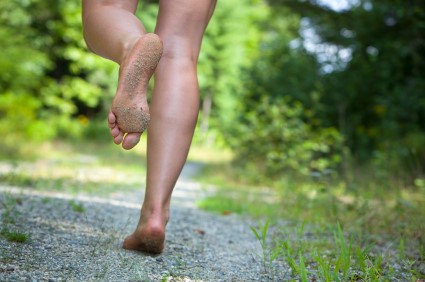 Barefoot running has long been debated to be either beneficial or detrimental to our feet, with arguments that barefoot running is natural, or that it can lead to extensive injury because our feet are conditioned to wear cushioned shoes. Research from Harvard anthropologist Daniel Lieberman and his fellow researchers suggested that minimalist running helped “deliver greater running economy and [led to] fewer injuries.” Barefoot running can offer an alternative lifestyle change for those interested in starting. When proper procedures are followed, the risk of injuries occurring from barefoot running decreases.
Barefoot running has long been debated to be either beneficial or detrimental to our feet, with arguments that barefoot running is natural, or that it can lead to extensive injury because our feet are conditioned to wear cushioned shoes. Research from Harvard anthropologist Daniel Lieberman and his fellow researchers suggested that minimalist running helped “deliver greater running economy and [led to] fewer injuries.” Barefoot running can offer an alternative lifestyle change for those interested in starting. When proper procedures are followed, the risk of injuries occurring from barefoot running decreases.
Barefoot running has its own share of benefits and disadvantages. If you have any concerns about your feet or ankles, contact Dr. Nicholas Megdanis from Greater Queens Podiatry PLLC. Our doctor will treat your foot and ankle needs.
Barefoot Running
The Impact of Barefoot Running
-Running without shoes changes the motion of your running, as most running is done by landing on the heel of the feet.
-Running barefoot requires a different way of running; the landing is done on the front part of the feet.
The Advantages of Barefoot Running
-When running and landing on the front feet, the impact on the feet and ankle is reduced, this can reduce stress injuries.
-It strengthens muscles in the feet and ankles and the lower legs.
-Balance of the body is improved and there is a greater sensory input from the feet to the rest of the body.
The Drawbacks of Barefoot Running
-No protection while running, makes it likely that runners will land on sharp objects and scrapes, bruises and cuts on the feet will result.
-Blisters may form.
-Possibility of plantar fascia problems.
-Risk of getting Achilles tendonitis.
So what can runners do to make barefoot running safe? It’s best to make a slow transition from running shoes to barefoot running. Once the feet begin to adjust, try walking, then jogging and gradually increasing the distance. Minimalist running shoes may also be an option.
If you have any questions, please feel free to contact our office located in Bayside, New York. We offer the newest diagnostic and treatment technologies for all your foot and ankle needs.
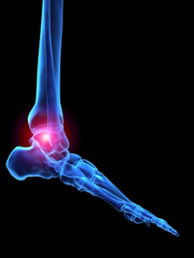 Osteoarthritis, a debilitating disease that affects your body’s tissue and cartilage, can affect people of all ages. Although osteoarthritis symptoms usually flare up around the age of 65, it can also affect younger individuals. Many different factors can contribute to osteoarthritis, including obesity, genes, and injuries, which can promote the early onset of symptoms. Osteoarthritis is a form of arthritis, which affects “1 in 5 adults in the United States,” which amounts to “at least 27 million Americans.”
Osteoarthritis, a debilitating disease that affects your body’s tissue and cartilage, can affect people of all ages. Although osteoarthritis symptoms usually flare up around the age of 65, it can also affect younger individuals. Many different factors can contribute to osteoarthritis, including obesity, genes, and injuries, which can promote the early onset of symptoms. Osteoarthritis is a form of arthritis, which affects “1 in 5 adults in the United States,” which amounts to “at least 27 million Americans.”
Arthritis can be a difficult condition to live with. If you are seeking treatment,contact Dr. Nicholas Megdanis from Greater Queens Podiatry PLLC. Our doctor will treat your foot and ankle needs.
Arthritic Foot Care
Arthritis is a joint disorder that involves inflammation of different joints in your body, such as in your feet. Arthritis is often caused by a degenerative joint disease and causes mild to severe pain in all affected areas. On top of this, swelling and stiffness in the affected joints can also be a common symptom of arthritis.
In many cases, wearing ill-fitting shoes can worsen the effects and pain of arthritis. Wearing shoes that have a lower heel and extra room can help your feet feel more comfortable. In cases of rheumatoid arthritis, the arch in your foot may become problematic. Buying shoes with proper arch support that contour to your feet can help immensely.
Alleviating Arthritic Pain
· Exercises that stretch the foot can prevent further pain and injury and increase mobility
· Most of the pain can be alleviated with anti-inflammatory drugs, heat, and topical medications
· Massages can help to temporarily alleviate pain.
It is best to see your doctor for the treatment that is right for your needs and symptoms. Conditions vary, and a podiatrist can help you determine the right method of care for your feet.
If you have any questions, please feel free to contact our office located in Bayside, New York. We offer the newest diagnostic and treatment technologies for all your foot and ankle needs.
 Cryotherapy is one potential treatment option for soothing the feet, especially if you have arthritis. First developed by the Japanese during the 1970s, cryotherapy is a “non-invasive, whole-body hyper-cooling treatment” that is often used for professional athletes. The method is said to reduce inflammation in the body through the rapid cooling of your body in -160 to -260 Fahrenheit temperatures.
Cryotherapy is one potential treatment option for soothing the feet, especially if you have arthritis. First developed by the Japanese during the 1970s, cryotherapy is a “non-invasive, whole-body hyper-cooling treatment” that is often used for professional athletes. The method is said to reduce inflammation in the body through the rapid cooling of your body in -160 to -260 Fahrenheit temperatures.
Foot therapy is necessary for those recovering from both foot deformities and foot injuries. If you have concerns regarding therapy, contact Dr. Nicholas Megdanis from Greater Queens Podiatry PLLC. Our doctor will treat your foot and ankle needs.
Most common injuries
People who are constantly on their feet are prone to a variety of injuries. Therefore, it is important to take part in physical therapy in order to get back on the right track quickly.
What to do when injured
Physical Therapy – This specialized treatment will focus on the affected area, speeding up recovery and the overall healing process. This is important for those wanting to get back into the game quickly. It is a proven method that has helped millions of people return from any injury.
During physical therapy you will undergo regimented training to get back into full form. Training is often very difficult, especially at first when the foot feels weak. These are some steps physical therapy often involves:
Basic stretching & twisting exercises – getting the feet’s mobility and flexibility up.
Massaging – the therapist will massage the injured area in order to activate the muscles and relax them.
Strengthening Exercises – this allows the muscles in the affected area to regain their full strength, a vital step towards full recovery.
If you have any questions, please feel free to contact our office located in Bayside, New York. We offer the newest diagnostic and treatment technologies for all your foot and ankle needs.
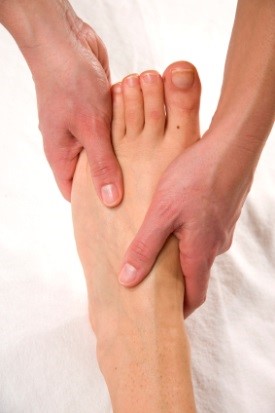 Diabetic foot ulcers are known as injuries on the feet that are suggested to be experienced by about “15 percent of diabetics,” and can usually start out small as blisters, calluses, or small cuts. Diabetic ulcers that are not treated can progress into a more serious issue, become infected, and can be extremely harmful for the diabetic person. Infections caused by diabetic ulcers can spread throughout the body and be difficult to treat at later stages. Diabetes can impair the blood cells and the immunity system.
Diabetic foot ulcers are known as injuries on the feet that are suggested to be experienced by about “15 percent of diabetics,” and can usually start out small as blisters, calluses, or small cuts. Diabetic ulcers that are not treated can progress into a more serious issue, become infected, and can be extremely harmful for the diabetic person. Infections caused by diabetic ulcers can spread throughout the body and be difficult to treat at later stages. Diabetes can impair the blood cells and the immunity system.
Diabetic foot care is important in preventing foot ailments such as ulcers. If you are seeking treatment, contact Dr. Nicholas Megdanis from Greater Queens Podiatry PLLC. Our doctor will treat your foot and ankle needs.
Diabetic Foot Care
Diabetes affects millions of people every year. Diabetes can damage blood vessels in many parts of the body, including the feet. Because of this, taking care of your feet is essential if you have diabetes, and having a podiatrist help monitor your foot health is highly recommended.
The Importance of Caring for Your Feet
· Routinely inspect your feet for bruises or sores.
· Wear comfortable shoes that provide adequate support.
Patients with diabetes should have their doctor monitor their blood levels because blood sugar levels play such a huge role in diabetic care. Monitoring these levels on a regular basis is highly advised.
It is always best to inform your healthcare professional of any concerns you may have regarding your feet, especially for diabetic patients. Early treatment and routine foot examinations are keys to maintaining proper health, especially because severe complications can arise if proper treatment is not applied.
If you have any questions, please feel free to contact our office located in Bayside, New York. We offer the newest diagnostic and treatment technologies for all your foot and ankle needs.
 Children’s feet and ankles are both especially prone to injury since they are not wholly developed yet. If your child participates often in sports, make sure to check them for bodily injuries. Softer surface sports can “create less trauma to the joints, whereas the harder surfaces can take their toll.” Small symptoms can progress into larger problems later on as your child grows older. Children can suffer from inflammation in the heel growth plate, also known as calcaneal apophysitis, achilles tendonitis, plantar fasciitis, and stress fractures. Repeated stress and strain on your children’s bodies can lead to these issues, so make sure to have them checked regularly.
Children’s feet and ankles are both especially prone to injury since they are not wholly developed yet. If your child participates often in sports, make sure to check them for bodily injuries. Softer surface sports can “create less trauma to the joints, whereas the harder surfaces can take their toll.” Small symptoms can progress into larger problems later on as your child grows older. Children can suffer from inflammation in the heel growth plate, also known as calcaneal apophysitis, achilles tendonitis, plantar fasciitis, and stress fractures. Repeated stress and strain on your children’s bodies can lead to these issues, so make sure to have them checked regularly.  There are many different symptoms and causes behind poor circulation, all of which can indicate serious problems in the body. Symptoms can commonly include feelings of numbness, cramps, the appearance of varicose veins, feelings of pins and needles, and feelings of heaviness on your limbs. Vascular disease is also another name for poor circulation in the body. Treating your poor blood circulation involves exercising more often, eating a healthy diet, and stopping smoking.
There are many different symptoms and causes behind poor circulation, all of which can indicate serious problems in the body. Symptoms can commonly include feelings of numbness, cramps, the appearance of varicose veins, feelings of pins and needles, and feelings of heaviness on your limbs. Vascular disease is also another name for poor circulation in the body. Treating your poor blood circulation involves exercising more often, eating a healthy diet, and stopping smoking.
Poor circulation is a serious condition and needs immediate medical attention.To learn more, contact Dr. Nicholas Megdanis from Greater Queens Podiatry PLLC. Our doctor will treat your foot and ankle needs.
Poor Circulation in the Feet
Poor blood circulation in the feet and legs can be caused by peripheral artery disease (PAD), which is the result of a buildup of plaque in the arteries.
Plaque buildup, or atherosclerosis, results from excess calcium and cholesterol in the bloodstream. It usually restricts the amount of blood which can flow through the arteries. Poor blood circulation in the feet and legs are sometimes caused by inflammation in the blood vessels, known as vasculitis.
Causes
Lack of oxygen from poor blood circulation restricts muscle growth and development. It can also cause:
-muscle pain -numbness in legs
-cramps -skin discoloration
-weakness -slower nail & hair growth
-stiffness -erectile dysfunction
Those who are over 50-years-old, have diabetes and/or smoke are at greatest risk for poor circulation. If you have poor circulation in the feet and legs it may be caused by PAD, and it is important to make changes to your lifestyle in order to reduce the risk of getting a heart attack or stroke. Exercising and maintaining a healthy lifestyle will dramatically improve conditions.
Consult a podiatrist or doctor to help determine a regime that suits you.
If you have any questions, please feel free to contact our office located in Bayside, New York. We offer the newest diagnostic and treatment technologies for all your foot and ankle needs.
| Bayside Office 4401 Francis Lewis Blvd Suite L3B Bayside, NY 11361 Phone: (718) 229-0222 Fax: (718) 717-0275 | Monday: 9:30am - 7pm |
E-mail us with any questions